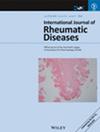Sjögren's Syndrome Is Associated With an Increased Risk of Vitiligo
Abstract
Objectives
Limited studies reported the correlation between Sjögren's syndrome (SS) and vitiligo. This study explores the association between SS and the risk of developing vitiligo and assesses comorbidity profiles and medication impacts.
Methods
We conducted a retrospective, population-based analysis using data from Taiwan's National Health Insurance Research Database, spanning 2008 to 2019. The primary outcome was the incidence of vitiligo, which was analyzed using Cox proportional hazards models, with additional subgroup and sensitivity analyses conducted.
Results
The study incorporated 223 582 individuals with SS and 9 775 363 controls. A total of 208 942 pairs of the SS and controls were analyzed following propensity score matching. Non-matched and matched cohort analyses have consistent results. In matched analysis, individuals with SS had a 1.90-fold increased risk of developing vitiligo compared to those without SS after adjustment (95% confidence interval [Cl], 1.67–2.15; p < 0.001). Age-related risk was evident, particularly in those aged 40–59 years and 60–79 years. Males had a lower risk of vitiligo than females. Comorbidities such as hyperlipidemia, chronic liver disease, hyperthyroidism, and spondylarthritis further increase the risk. During the first year following diagnosis, individuals with SS exhibited a significantly elevated risk of developing vitiligo compared to those without SS (aHR, 2.15; 95% Cl, 1.54–3.00; p < 0.001). Over a decade of follow-up, the SS cohort showed a markedly higher cumulative risk of vitiligo than the non-SS cohort (log-rank p < 0.001). Subgroup analysis revealed that systemic corticosteroid administration significantly mitigated the risk of developing vitiligo in SS patients (aHR, 0.67; 95% CI, 0.53–0.86; p < 0.001) compared to patients who did not receive systemic corticosteroids.
Conclusion
SS is significantly associated with an increased risk of developing vitiligo. Further research is warranted to elucidate the underlying mechanisms.

 求助内容:
求助内容: 应助结果提醒方式:
应助结果提醒方式:


